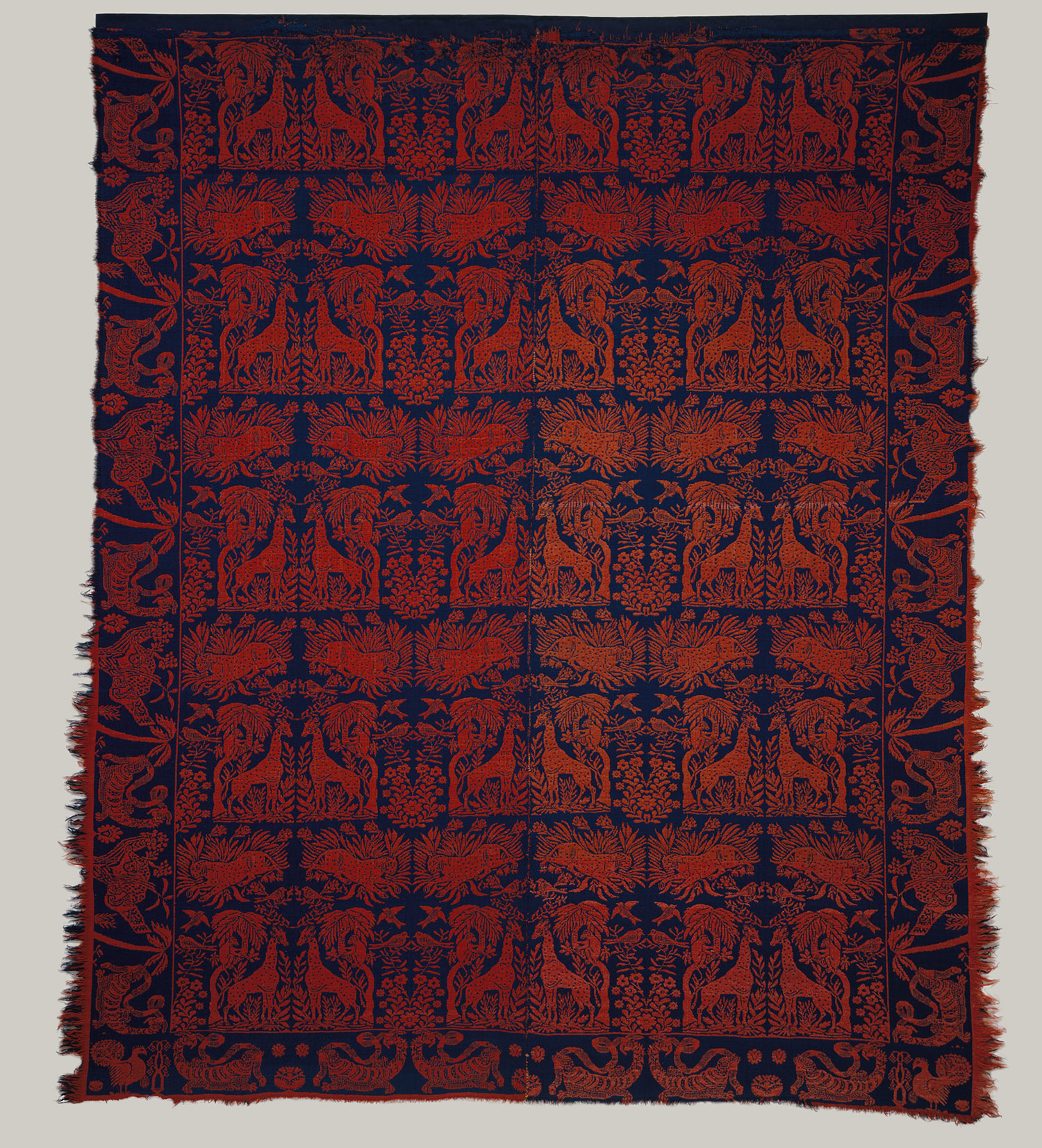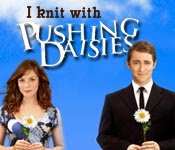Wednesday, October 28, 2009
SOAR!
I'm off to SOAR in Bend, Oregon! My flight leaves later this morning and I'll arrive in the Bend airport around 7 their time. I'm not planning on blogging from SOAR but I will take plenty of pictures for you, learn lots of things to share, and meet tons of fantastic people! I'll be back early Monday morning (so very early) so look for a post after that.
Thursday, October 15, 2009
Soctober!
Yeah, so I fail at being up to date. I meant to post about Socktober in the first couple of days of October but time passed me by. Have you been knitting socks (or something with sock yarn) this October? I have!
I finished my first pair of socks in 8 days! During school, I could finish a pair that quickly because of all the 3 hour classes ofknitting I mean learning time. I think this pair went so quickly because I really wanted to see the way the cables would turn out. The pattern was Midsummer Night's Dream from Knitty. It has leaves growing up the front of the sock.

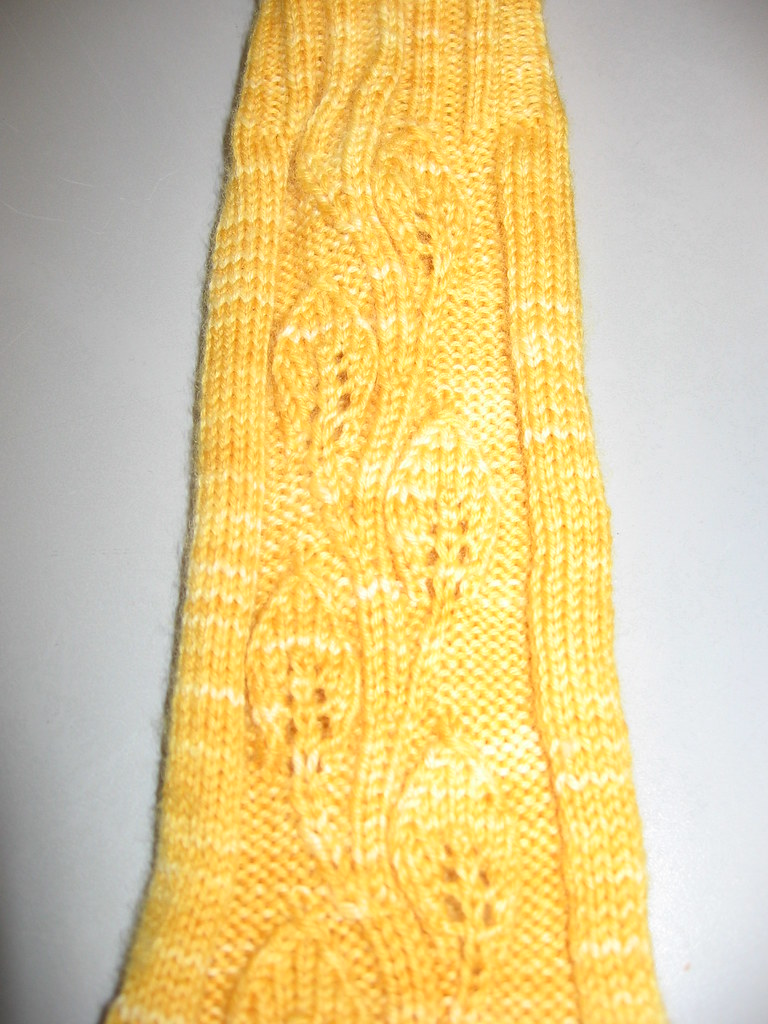
Sorry for the bad pictures. It's deciding to be cold and rainy here today.
Pattern: Midsummer Night's Dream
Yarn: Fancy Dancing Feet, a superwash wool
Needles: US 2, 2.75mm
Dates: Oct 2 - 10, 2009
Modifications: I used my own toe pattern and the sockitecture from Cat Bordhi's Riverbed pattern. That sockitecture is fast becoming my favorite way of doing socks.
My next project wasn't a pair of socks but it was knit out of fingering weight yarn. A couple of yarn festivals ago, I bought some sock yarn in OSU colors, scarlet and grey. Dad is a huge OSU fan so I was going to make a pair of socks for him. That was before I learned that he likes knee highs (well, knee highs for me but midcalves for him) and I really couldn't face doing all of that knitting. Also, I only had bought one skein of yarn. True, it is a very generous skein but not enough for my 6'4" father's feet. Anyway, this yarn has been hanging around my stash for a while now looking lonely. I decided that, if I wasn't going to use it for socks, I should do something with it. After poking around ravelry for a bit, I decided the yarn was destined to be a hat.
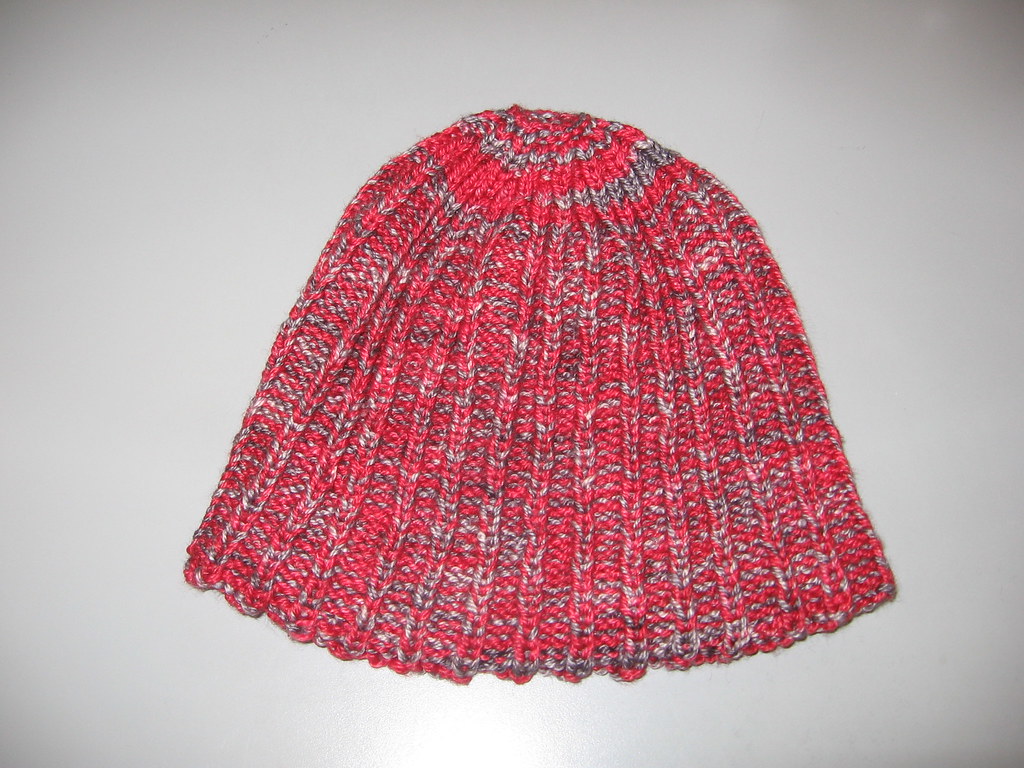
I doubled the yarn and cast on 112 stitches. I did a 3x1 ribbing which doesn't look that exciting on the right side but, when you turn it inside-out, the pattern looks really interesting. I cast on before going to the Quarter Horse Congress with friends, knit on it while we were walking around, and finished it after we sat around a bit and watched a couple of different classes. Definitely a quick little project.
Pattern: None really
Yarn: Yarnsmith Mazu, wool/seacell blend but I've lost the label
Needles: US 6, 4 mm
Dates: Oct 11
Modifications: Well, since I was making it up as I went along, none really.
After finishing that OSU hat, I immediately cast on for another one but with a different yarn. The yarn is one of my handspun yarns, a DK weight called Rainbow Fleece. It is 100% soysilk and was naturally dyed by Earthly Hues.
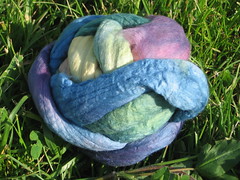
I spun the singles for this yarn back in 2008 and then finally plied everything this past July. The chain plying I did kept all of those colors together and the finished product has a really nice rainbow transition.

After I had finished the yarn, it was calling out to be made into some sort of hat. I pictured some sort of simple ribbed hat so that the pattern and the yarn would work well together. July, then August, then September all passed without me doing anything with this yarn. When I was grabbing the yarn for the other hat, I decided at the last minute to throw this one in my bag, too. This hat took me much longer to finish because a) it wasn't the weekend anymore, b) the house is cold and I didn't want to take my hands from under the sheepskin blanket, and c) I wanted to use up all of the yarn and that made it much longer than the other. I really wanted all of the colors to show up in the hat because what would be the point to have a rainbow hat without the purple?
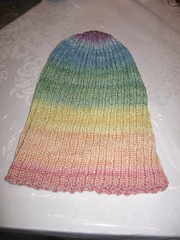
Pattern: None really
Yarn: Handspun, Rainbow Fleece, 100% soysilk
Needles: US 6, 4 mm
Dates: Oct 11 - Oct 14
Modifications: Apparently, I forgot the pattern from one minute to the next and did a 2x1 rib rather than 3x1.
I am apparently on a hat kick because I've started another one (!). This time, I'm doubling sock yarn again and making sure that I do a 3x1 rib. I don't think I even have this yarn in my ravelry stash because it has been in the stash for so long. It was probably the second sock yarn that I bought and I made one sock out of it back when I was doing socks one at a time. Yeah, that didn't last long. I know that SSS hits me badly and knitting two socks at a time is the only way that I get pairs done. Another reason this sock didn't last was that the yarn pooled horribly around the ankle. So it was time to reuse the yarn for something else. I think that this hat will go in the holiday gift pile for a recipient to be named.
Hopefully, I'll continue with Socktober and be able to finish up at least one other pair of socks before the end of the month. I have a number of WIPs hanging around including a pair of toe-up Jaywalkers on which I've turned the heel and just need to do the leg. There is also a pair of cabled knee highs from last Socktober that have the entire intricate leg finished and I just have to turn the heel and finish the foot. Simple, really, after all of the work on the leg. Remind me why haven't I already finished them?
Oh! I almost forgot what I'm calling the Blanket of Insanity aka sock yarn blanket. I'm still continuing with the squares but now I have to finish up some socks in order to get the leftovers. Thanks to the Midsummer socks there is plenty of yellow left and I have a little bit of the OSU yarn from the hat left, too. Right now, there are somewhere between 45-50 squares finished with their ends woven in.
I finished my first pair of socks in 8 days! During school, I could finish a pair that quickly because of all the 3 hour classes of


Sorry for the bad pictures. It's deciding to be cold and rainy here today.
Pattern: Midsummer Night's Dream
Yarn: Fancy Dancing Feet, a superwash wool
Needles: US 2, 2.75mm
Dates: Oct 2 - 10, 2009
Modifications: I used my own toe pattern and the sockitecture from Cat Bordhi's Riverbed pattern. That sockitecture is fast becoming my favorite way of doing socks.
My next project wasn't a pair of socks but it was knit out of fingering weight yarn. A couple of yarn festivals ago, I bought some sock yarn in OSU colors, scarlet and grey. Dad is a huge OSU fan so I was going to make a pair of socks for him. That was before I learned that he likes knee highs (well, knee highs for me but midcalves for him) and I really couldn't face doing all of that knitting. Also, I only had bought one skein of yarn. True, it is a very generous skein but not enough for my 6'4" father's feet. Anyway, this yarn has been hanging around my stash for a while now looking lonely. I decided that, if I wasn't going to use it for socks, I should do something with it. After poking around ravelry for a bit, I decided the yarn was destined to be a hat.

I doubled the yarn and cast on 112 stitches. I did a 3x1 ribbing which doesn't look that exciting on the right side but, when you turn it inside-out, the pattern looks really interesting. I cast on before going to the Quarter Horse Congress with friends, knit on it while we were walking around, and finished it after we sat around a bit and watched a couple of different classes. Definitely a quick little project.
Pattern: None really
Yarn: Yarnsmith Mazu, wool/seacell blend but I've lost the label
Needles: US 6, 4 mm
Dates: Oct 11
Modifications: Well, since I was making it up as I went along, none really.
After finishing that OSU hat, I immediately cast on for another one but with a different yarn. The yarn is one of my handspun yarns, a DK weight called Rainbow Fleece. It is 100% soysilk and was naturally dyed by Earthly Hues.

I spun the singles for this yarn back in 2008 and then finally plied everything this past July. The chain plying I did kept all of those colors together and the finished product has a really nice rainbow transition.

After I had finished the yarn, it was calling out to be made into some sort of hat. I pictured some sort of simple ribbed hat so that the pattern and the yarn would work well together. July, then August, then September all passed without me doing anything with this yarn. When I was grabbing the yarn for the other hat, I decided at the last minute to throw this one in my bag, too. This hat took me much longer to finish because a) it wasn't the weekend anymore, b) the house is cold and I didn't want to take my hands from under the sheepskin blanket, and c) I wanted to use up all of the yarn and that made it much longer than the other. I really wanted all of the colors to show up in the hat because what would be the point to have a rainbow hat without the purple?

Pattern: None really
Yarn: Handspun, Rainbow Fleece, 100% soysilk
Needles: US 6, 4 mm
Dates: Oct 11 - Oct 14
Modifications: Apparently, I forgot the pattern from one minute to the next and did a 2x1 rib rather than 3x1.
I am apparently on a hat kick because I've started another one (!). This time, I'm doubling sock yarn again and making sure that I do a 3x1 rib. I don't think I even have this yarn in my ravelry stash because it has been in the stash for so long. It was probably the second sock yarn that I bought and I made one sock out of it back when I was doing socks one at a time. Yeah, that didn't last long. I know that SSS hits me badly and knitting two socks at a time is the only way that I get pairs done. Another reason this sock didn't last was that the yarn pooled horribly around the ankle. So it was time to reuse the yarn for something else. I think that this hat will go in the holiday gift pile for a recipient to be named.
Hopefully, I'll continue with Socktober and be able to finish up at least one other pair of socks before the end of the month. I have a number of WIPs hanging around including a pair of toe-up Jaywalkers on which I've turned the heel and just need to do the leg. There is also a pair of cabled knee highs from last Socktober that have the entire intricate leg finished and I just have to turn the heel and finish the foot. Simple, really, after all of the work on the leg. Remind me why haven't I already finished them?
Oh! I almost forgot what I'm calling the Blanket of Insanity aka sock yarn blanket. I'm still continuing with the squares but now I have to finish up some socks in order to get the leftovers. Thanks to the Midsummer socks there is plenty of yellow left and I have a little bit of the OSU yarn from the hat left, too. Right now, there are somewhere between 45-50 squares finished with their ends woven in.
Friday, October 09, 2009
National Museum of the American Coverlet
I happened to be in south central PA last week and used the opportunity to visit with friends and then stop by the National Museum of the American Coverlet in Bedford, PA. You are probably asking yourself, "What is an American coverlet?" Well, are you ready for some education? In the following post, images have been taken from a number of different museums. If you would like more information, please click on the links under each of the pictures.
 Picture from the National Museum of the American Coverlet website
Picture from the National Museum of the American Coverlet website
(sidenote: that is the style of walking wheel that I have)
Early Coverlets
American coverlets, according to the gentleman who took me on an in-depth personal tour of the museum, are a thoroughly American art. They are woven blankets which were made in America (and limited parts of Canada) by European weavers who had emigrated to America. Early coverlets are defined by their geometric designs. Early ones typically have a center seam because the looms that wove them were small. One of the examples in the museum was really interesting because the coverlet had been taken apart, repaired and sewn back incorrectly. The border of one side was sewn together with the center of the other side. The early weavers created geometric patterns because they were limited by their technology. At the time, the looms they owned were unable to make complex designs. All of that changed when the Jacquard loom was brought to America.
Jacquard looms
As those interested in the history of computers will know, a Jacquard loom is an example of an early computer. A Jacquard loom is, according to Merriam-Webster, "a loom designed to weave fabrics of intricate design whose control mechanism makes use of cards with holes punched in them."
Those cards allowed weavers to move beyond the simple geometric designs. Suddenly, they could make works of art rather than just beautiful blankets. At this time, coverlets began being signed and dated thanks to the Jacquard loom.
 Scanned image from American Coverlets and Their Weavers
Scanned image from American Coverlets and Their Weavers
An English weaver's coverlet, on the other hand, had English symbols like lions or the English rose. Also, the border of the English weavers' coverlets were different that those of other European weavers. Their borders were bound off without tassels or fringe. Many English weavers settled in the New York area.
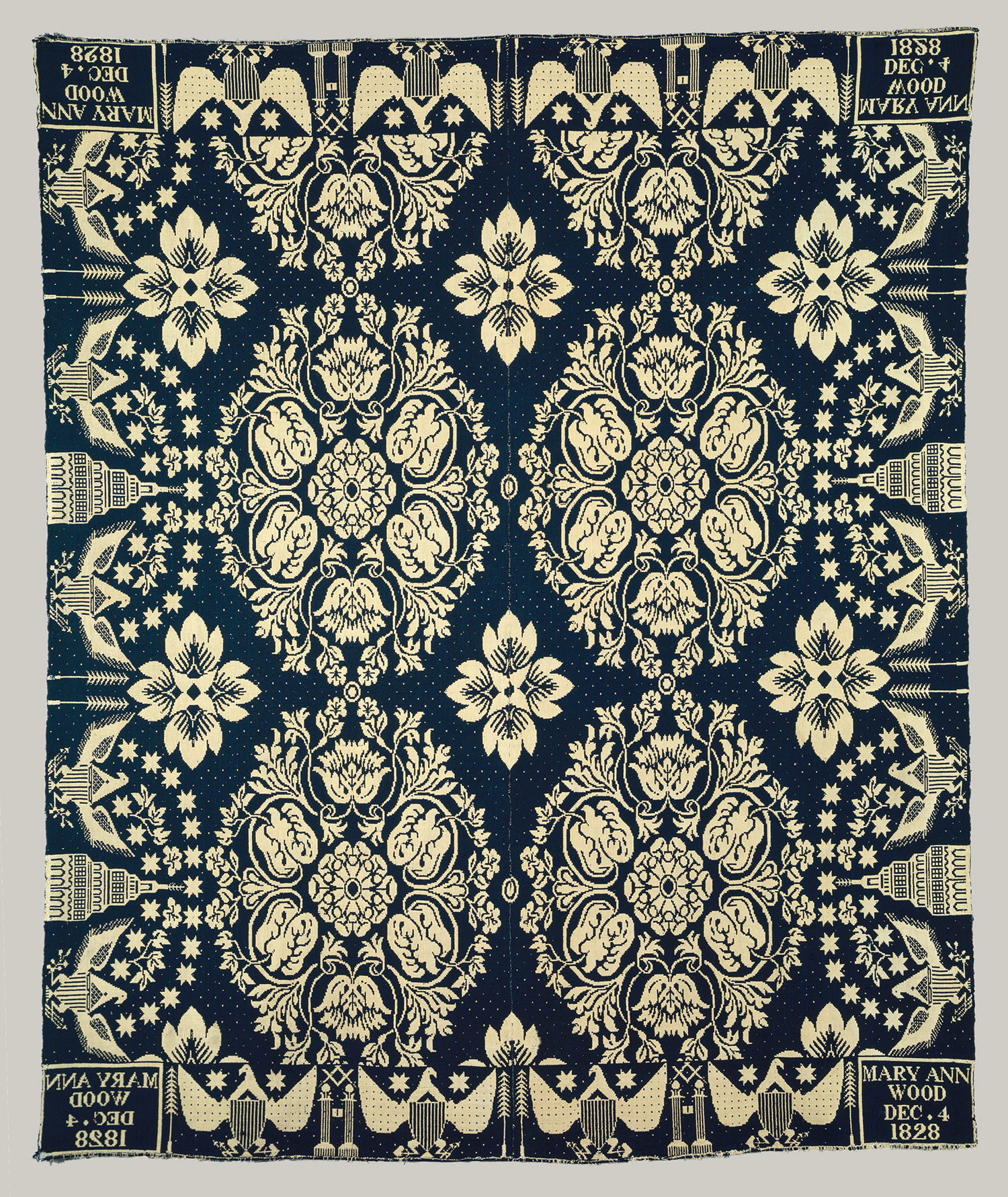 New York quilt, The Metropolitan Museum of Art
New York quilt, The Metropolitan Museum of Art
Once the weavers began moving west, however, their styles began to blend. Elements of the different nationalities as well as traditional American symbols were common. By the time the weavers hit Indiana, they had developed a very cohesive style. The following image is from a coverlet that the Metropolitan Museum of Art believes was woven by an Ohio weaver. It shows a combination of the different elements.
Country Living had an article in the May 2007 issue about American coverlets. If you would like additional information, click here.
Stay at Home and Use Me Well Exhibit
From now until next year, the museum is having a special exhibit of spinning wheels and accessories.
 I don't have any pictures from this display because I was the only person there and was having a guided tour. I'm sure Mr. Zongor wouldn't have minded but I didn't want to impose.
I don't have any pictures from this display because I was the only person there and was having a guided tour. I'm sure Mr. Zongor wouldn't have minded but I didn't want to impose.
The wheels on display were the property of one man. Now, that doesn't sound that impressive until you see how many items were in the museum. I can't even picture where that man keeps it all! It makes me wonder how I can work it so that he adopts me. The variety of wheels were simply amazing. He had walking wheels, production wheels, a pulley wheel, flax wheels, wool wheels, upright wheels, more traditional wheels, double flyer wheels, TONS of mothers of all, etc etc. AMAZING. If you are interested in antique spinning wheels at all, go see the exhibit. It was really fascinating to see all of the different types in one place.
If you are in the area, make sure you drop by the museum. For a small museum, they have really good hours. They are located in historical Bedford, PA right off of the PA turnpike.
 Picture from the National Museum of the American Coverlet website
Picture from the National Museum of the American Coverlet website(sidenote: that is the style of walking wheel that I have)
Early Coverlets
American coverlets, according to the gentleman who took me on an in-depth personal tour of the museum, are a thoroughly American art. They are woven blankets which were made in America (and limited parts of Canada) by European weavers who had emigrated to America. Early coverlets are defined by their geometric designs. Early ones typically have a center seam because the looms that wove them were small. One of the examples in the museum was really interesting because the coverlet had been taken apart, repaired and sewn back incorrectly. The border of one side was sewn together with the center of the other side. The early weavers created geometric patterns because they were limited by their technology. At the time, the looms they owned were unable to make complex designs. All of that changed when the Jacquard loom was brought to America.
Jacquard looms
As those interested in the history of computers will know, a Jacquard loom is an example of an early computer. A Jacquard loom is, according to Merriam-Webster, "a loom designed to weave fabrics of intricate design whose control mechanism makes use of cards with holes punched in them."
Those cards allowed weavers to move beyond the simple geometric designs. Suddenly, they could make works of art rather than just beautiful blankets. At this time, coverlets began being signed and dated thanks to the Jacquard loom.
 Scanned image from American Coverlets and Their Weavers
Scanned image from American Coverlets and Their WeaversAccording to the gentleman at the museum, the woman's name on the coverlet always refers to the recipient of the coverlet. There is only one recorded instance of a woman weaver making woven coverlets. The investment cost for purchase of the Jacquard loom and punchcards was so much that only well-established men could afford to buy them. The lady who wove coverlets inherited the loom and punchcards from her father.
The signature blocks allow us to know such a wealth of information about the weavers and their recipients. If you have a chance, take a look at the book, American Coverlets and Their Weavers by Clarita Anderson. The author looked through numerous census records and was able to find some fascinating information about the weavers.
Coverlets as art and function
I found it very interesting to learn that coverlets were probably one of the first things in a household that were bought simply to be pretty. The first items bought (or made) for a house would be things like furniture or kitchen equipment. A coverlet, on the other hand, was extremely expensive and would only be displayed on the master bed.
Melting Pot of America
In a very physical way, coverlets show explain why America is called a melting pot. When the European weavers first settled in America, their coverlets had distinct images and styles. For instance, a German weaver's coverlet reminded me very much of hex signs found on Pennsylvania Dutch barns.
The signature blocks allow us to know such a wealth of information about the weavers and their recipients. If you have a chance, take a look at the book, American Coverlets and Their Weavers by Clarita Anderson. The author looked through numerous census records and was able to find some fascinating information about the weavers.
Coverlets as art and function
I found it very interesting to learn that coverlets were probably one of the first things in a household that were bought simply to be pretty. The first items bought (or made) for a house would be things like furniture or kitchen equipment. A coverlet, on the other hand, was extremely expensive and would only be displayed on the master bed.
Melting Pot of America
In a very physical way, coverlets show explain why America is called a melting pot. When the European weavers first settled in America, their coverlets had distinct images and styles. For instance, a German weaver's coverlet reminded me very much of hex signs found on Pennsylvania Dutch barns.
 New York quilt, The Metropolitan Museum of Art
New York quilt, The Metropolitan Museum of ArtOnce the weavers began moving west, however, their styles began to blend. Elements of the different nationalities as well as traditional American symbols were common. By the time the weavers hit Indiana, they had developed a very cohesive style. The following image is from a coverlet that the Metropolitan Museum of Art believes was woven by an Ohio weaver. It shows a combination of the different elements.
Country Living had an article in the May 2007 issue about American coverlets. If you would like additional information, click here.
Stay at Home and Use Me Well Exhibit
From now until next year, the museum is having a special exhibit of spinning wheels and accessories.
 I don't have any pictures from this display because I was the only person there and was having a guided tour. I'm sure Mr. Zongor wouldn't have minded but I didn't want to impose.
I don't have any pictures from this display because I was the only person there and was having a guided tour. I'm sure Mr. Zongor wouldn't have minded but I didn't want to impose.The wheels on display were the property of one man. Now, that doesn't sound that impressive until you see how many items were in the museum. I can't even picture where that man keeps it all! It makes me wonder how I can work it so that he adopts me. The variety of wheels were simply amazing. He had walking wheels, production wheels, a pulley wheel, flax wheels, wool wheels, upright wheels, more traditional wheels, double flyer wheels, TONS of mothers of all, etc etc. AMAZING. If you are interested in antique spinning wheels at all, go see the exhibit. It was really fascinating to see all of the different types in one place.
If you are in the area, make sure you drop by the museum. For a small museum, they have really good hours. They are located in historical Bedford, PA right off of the PA turnpike.
Subscribe to:
Comments (Atom)



